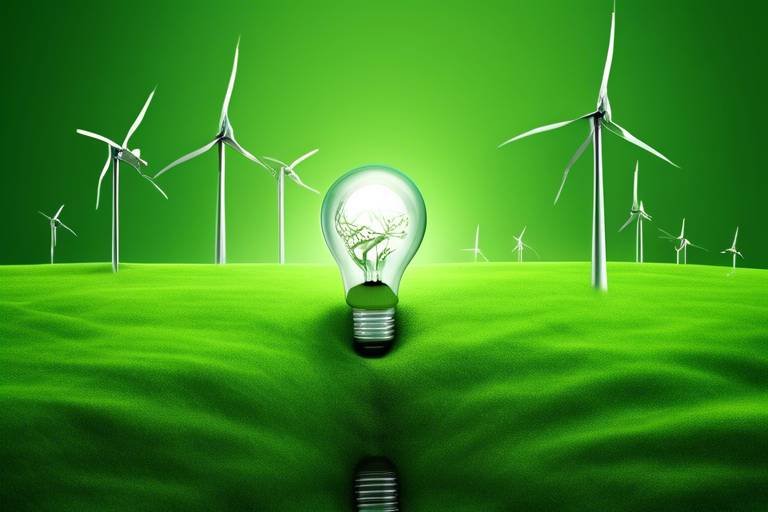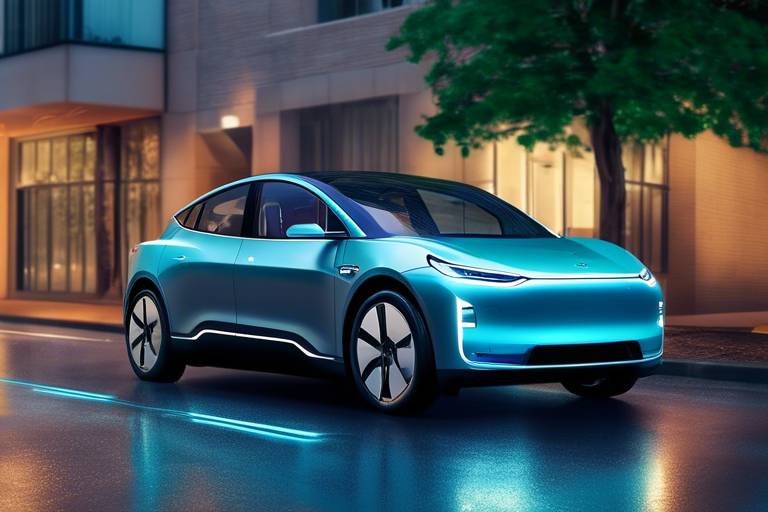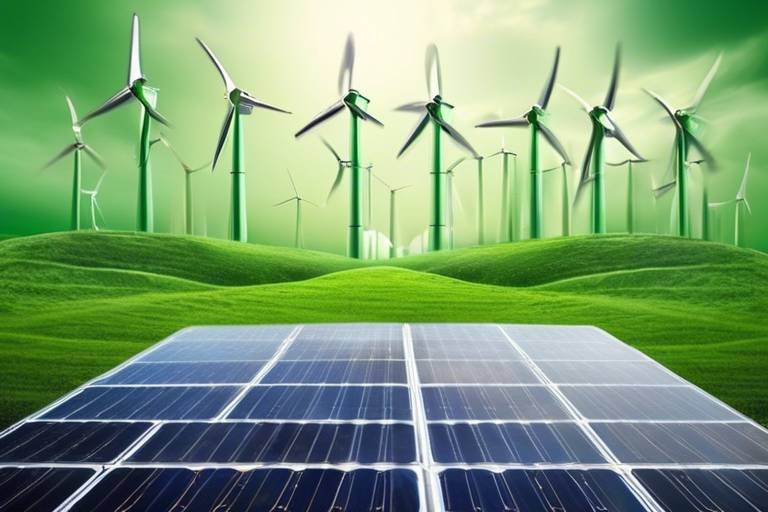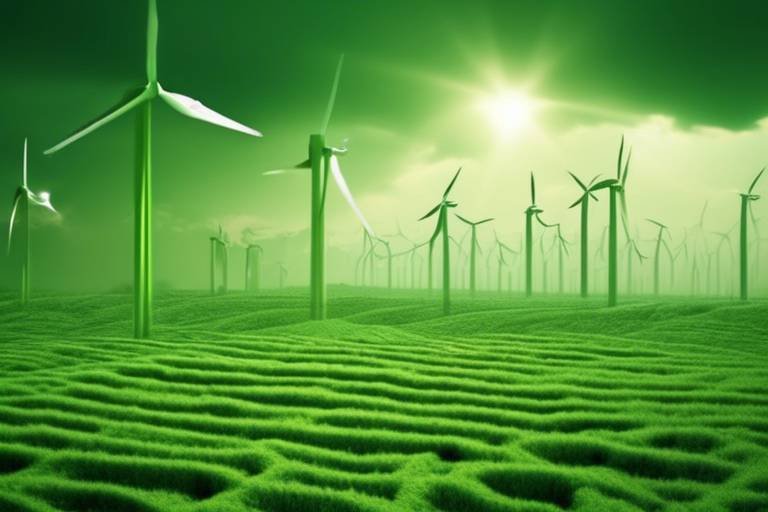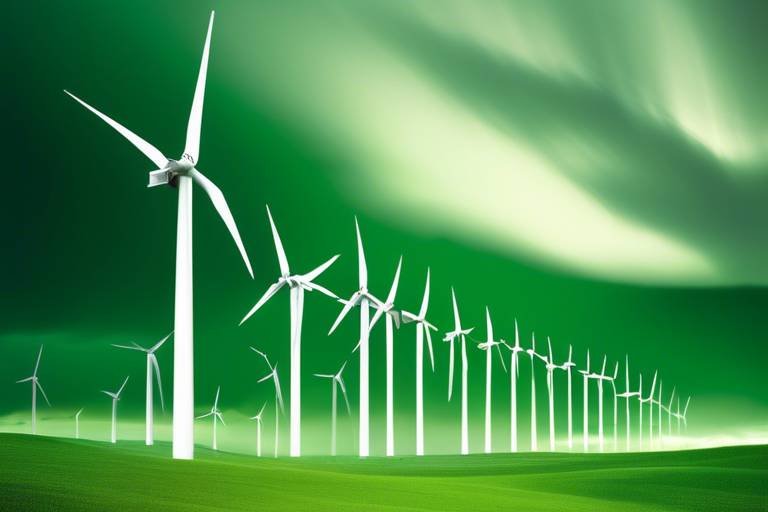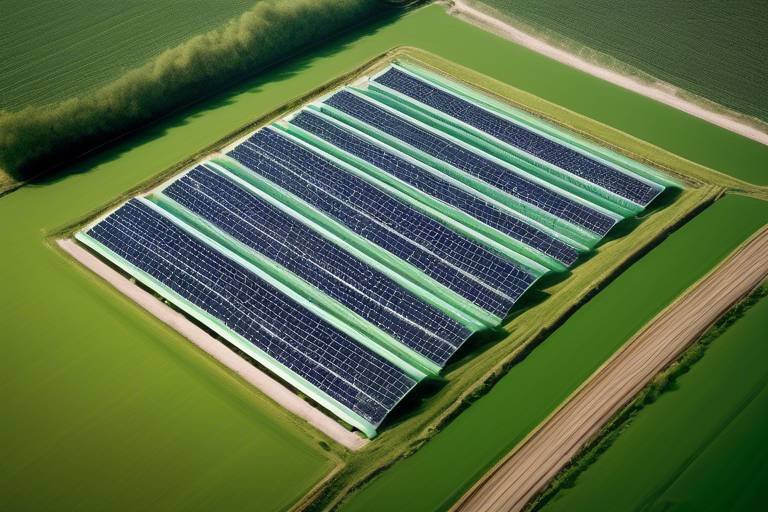Unconventional Green Energy Solutions – An Exploration
As the world grapples with the pressing need to address climate change and reduce our carbon footprint, the quest for innovative green energy solutions has never been more critical. Traditional energy sources, primarily fossil fuels, are proving to be unsustainable and detrimental to our planet. This article delves into some of the most unconventional yet promising green energy solutions that not only aim to provide sustainable living but also offer a glimpse into a cleaner, greener future. From harnessing the power of the ocean to utilizing the heat beneath our feet, these solutions are paving the way for a more sustainable energy landscape.
One of the most exciting aspects of these alternative energy sources is their potential to transform the way we think about energy production. Imagine a world where our energy needs are met by resources that are abundant, renewable, and environmentally friendly. This isn't just a dream; it's becoming a reality through the development of technologies that tap into nature's own systems. In this exploration, we'll look at various unconventional energy solutions, their benefits, and the challenges they face as they strive for wider adoption.
So, what are these innovative solutions? They encompass a variety of technologies, including biomass energy, ocean energy, and geothermal energy. Each of these sources offers unique advantages and presents its own set of challenges. Biomass energy, for instance, utilizes organic materials, which can be a sustainable alternative to fossil fuels. Ocean energy harnesses the power of waves and tides, while geothermal energy taps into the Earth's natural heat. Together, they represent a diverse toolkit for combating climate change and achieving energy independence.
Throughout this article, we will not only explore the mechanics behind these technologies but also their real-world applications and the impact they can have on our daily lives. As we embark on this journey through the realm of unconventional green energy solutions, let's keep in mind the ultimate goal: to create a sustainable future where energy is clean, affordable, and accessible to all.
- What is biomass energy? Biomass energy is derived from organic materials, such as plants and waste, which can be converted into fuel for heating, electricity, or transportation.
- How does ocean energy work? Ocean energy captures the movement of water, whether through waves or tides, to generate electricity, utilizing technologies like wave energy converters and tidal systems.
- What are the benefits of geothermal energy? Geothermal energy is a reliable and constant source of energy that can provide heating and electricity with minimal environmental impact.
- Are these green energy solutions cost-effective? While the initial investment may be high, many unconventional green energy solutions can lead to long-term savings and energy independence.

Biomass Energy: A Renewable Resource
Biomass energy is one of the most fascinating and renewable resources available to us today. It harnesses organic materials—think of everything from agricultural waste to wood chips—to create energy. This process not only provides a sustainable alternative to fossil fuels but also helps us tackle the pressing issue of waste management. Imagine turning leftover food scraps or crop residues into energy; it's like turning trash into treasure! The beauty of biomass is that it can be sourced from a variety of materials, making it an incredibly versatile energy option.
One of the primary benefits of biomass energy is its carbon neutrality. When biomass is burned for energy, it releases carbon dioxide (CO2) into the atmosphere. However, the plants that were used to create that biomass absorbed CO2 while they were growing. In a way, it’s a cycle—plants grow, absorb CO2, get converted into energy, and the cycle continues. This means that, unlike fossil fuels, biomass doesn’t contribute to an increase in atmospheric CO2 levels in the long run. It’s a win-win for our planet!
However, like any energy source, biomass energy comes with its own set of challenges. For instance, the process of collecting and transporting biomass can be energy-intensive and costly. Additionally, there are concerns about land use; if we start using too much agricultural land for biomass production, it could lead to food shortages. Balancing biomass production with food production is crucial for a sustainable future.
Let’s take a closer look at some of the key sources of biomass energy:
- Agricultural Residues: Leftover crops like corn stalks and wheat straw.
- Wood Waste: Sawdust, wood chips, and tree trimmings from lumber mills.
- Animal Manure: Waste from livestock can be converted into biogas.
- Energy Crops: Crops specifically grown for energy production, such as switchgrass.
In terms of applications, biomass can be converted into electricity, heat, or biofuels. Biomass power plants burn organic materials to produce steam, which drives turbines to generate electricity. Alternatively, biomass can be processed into biofuels like ethanol or biodiesel, which can power our cars and trucks. This flexibility makes biomass a crucial player in the transition to renewable energy.
In conclusion, biomass energy stands out as a promising renewable resource that not only helps reduce our reliance on fossil fuels but also provides innovative solutions to waste management. As we continue to explore and invest in this energy source, we open doors to a more sustainable and environmentally friendly future. The potential is immense, and with the right practices in place, biomass can play a significant role in achieving our energy goals.
What is biomass energy?
Biomass energy is derived from organic materials, such as plants and animal waste, that can be converted into electricity, heat, or biofuels.
Is biomass energy renewable?
Yes, biomass energy is considered renewable because the organic materials used can be replenished over time.
What are the environmental benefits of biomass energy?
Biomass energy is carbon neutral, helps reduce waste, and can lower greenhouse gas emissions when compared to fossil fuels.
What challenges does biomass energy face?
Challenges include the energy cost of collection and transportation, potential land use conflicts, and ensuring sustainable practices in biomass production.

Ocean Energy: Tapping the Power of Waves
Ocean energy is one of the most exciting and underutilized renewable energy sources available to us today. Imagine harnessing the immense power of the waves and tides that constantly crash against our shores—it's like capturing the heartbeat of the Earth itself! As we face the urgent need to transition away from fossil fuels, ocean energy presents a compelling solution that could significantly reduce our carbon footprint while providing a sustainable energy source for generations to come.
There are two primary forms of ocean energy: wave energy and tidal energy. Both leverage the natural movements of water to generate electricity, but they do so in distinct ways. Wave energy focuses on the energy produced by surface waves, while tidal energy taps into the gravitational forces exerted by the moon and sun, which cause the ocean's tides. Both methods have their unique technologies and applications, and together they offer a robust toolkit for sustainable energy production.
Wave energy converters (WECs) are the devices that capture the energy from ocean waves. These innovative technologies come in various shapes and sizes, designed to optimize energy extraction based on the specific characteristics of the waves they encounter. For instance, some WECs are designed to float on the surface, while others are submerged beneath the waves. The efficiency of these devices can vary, but advancements in technology are continually improving their performance. It's like finding the perfect surfboard that rides the waves just right—when you get it right, the energy harvested can be substantial.
When we dive deeper into wave energy converters, we find fascinating designs and mechanisms at play. One popular type is the point absorber, which floats on the surface and captures energy from the vertical motion of waves. Think of it as a buoy that bobs up and down, harnessing the energy from each rise and fall. This design is particularly effective in deep water, where wave energy is more consistent and powerful.
Another innovative design is the oscillating water column (OWC). This system utilizes trapped air and the movement of water to generate electricity. As waves enter the chamber, they push the water level up and down, forcing air through a turbine that generates power. The beauty of OWCs lies in their simplicity and efficiency; they can be installed along coastlines or integrated into existing structures, making them a versatile option for energy generation.
On the other hand, tidal energy systems offer a different approach to harnessing the ocean's power. By exploiting the gravitational pull of the moon and sun, these systems can generate electricity reliably and predictably. Unlike wind or solar energy, which can fluctuate based on weather conditions, tidal energy is highly consistent. It's like clockwork—tides come in and out, and with them, the potential for energy generation.
However, the implementation of tidal energy systems does come with its own set of challenges. Environmental considerations must be taken into account to ensure that marine ecosystems are not disrupted. The construction of tidal turbines can impact local wildlife and habitats, so careful planning and monitoring are essential. By balancing energy needs with environmental stewardship, we can create a future where tidal energy plays a significant role in our energy landscape.
In summary, ocean energy presents an incredible opportunity to tap into the natural forces of our planet. With ongoing research and development, we can refine these technologies and make them more efficient, paving the way for a cleaner, greener future. The ocean is vast and full of potential, and by harnessing its power, we can make strides toward sustainable living.
- What is ocean energy? Ocean energy refers to the energy harnessed from the movement of water, including wave and tidal energy.
- How does wave energy work? Wave energy converters capture the energy from surface waves, converting it into electricity through various mechanisms.
- Are there environmental concerns with ocean energy? Yes, while ocean energy is a renewable resource, its implementation can impact marine ecosystems, necessitating careful planning and monitoring.
- What is the difference between wave and tidal energy? Wave energy is generated from surface waves, while tidal energy is produced by the gravitational pull of the moon and sun, causing ocean tides.

Wave Energy Converters
Wave energy converters (WECs) are fascinating devices that capture the energy generated by ocean waves and convert it into electricity. Imagine standing on a beach, feeling the rhythmic pull of the waves, and knowing that these very movements can power our homes and cities. It's like having a never-ending source of energy right at our fingertips! As the world looks for sustainable solutions to combat climate change, WECs present a promising avenue for harnessing renewable energy.
There are several types of wave energy converters, each with its unique design and operational principles. These devices can be broadly categorized into two main types: point absorbers and oscillating water columns. Point absorbers float on the surface of the water and capture energy from the vertical motion of waves. On the other hand, oscillating water columns utilize trapped air and water movement to generate electricity, creating a fascinating interplay between natural forces and technology. The efficiency of these devices can vary significantly, but advancements in engineering are continually improving their performance.
One of the most intriguing aspects of wave energy converters is their ability to operate in diverse environmental conditions. Unlike solar or wind energy, which can be intermittent, ocean waves are consistently generated by wind patterns, making WECs a reliable energy source. However, the implementation of these technologies is not without its challenges. Factors such as marine life impact, installation costs, and maintenance requirements must be carefully considered. To address these challenges, researchers are continually exploring innovative designs and materials to enhance the durability and efficiency of wave energy converters.
In terms of potential applications, WECs can be deployed in various settings, from coastal regions to offshore platforms. They can provide power for remote communities, contribute to grid stability, and even support desalination processes. The integration of wave energy into our existing energy systems could significantly reduce our reliance on fossil fuels, leading to a cleaner and more sustainable future.
As we move forward, the development of wave energy converters could play a crucial role in the global transition to renewable energy. With continued investment and research, these devices have the potential to transform the way we think about energy generation. Imagine a world where the power of the ocean fuels our lives—it's not just a dream; it's a possibility within our reach!
- What are wave energy converters? Wave energy converters are devices that capture the energy of ocean waves and convert it into electricity.
- How do point absorbers work? Point absorbers float on the water's surface and harness energy from the vertical motion of waves.
- What are oscillating water columns? Oscillating water columns use trapped air and water movement to generate electricity.
- Are wave energy converters environmentally friendly? Yes, they offer a renewable energy source, but their environmental impact must be carefully managed.
- Where can wave energy converters be installed? They can be deployed in coastal areas and offshore platforms, making them versatile for various applications.

Point Absorbers
When we talk about wave energy converters, one of the most fascinating types is the point absorber. These ingenious devices float on the surface of the ocean, capturing energy from the vertical motion of waves. Imagine a buoy bobbing up and down, harnessing the very essence of the ocean's rhythm to generate electricity. This technology is not just innovative; it's a game changer in the quest for sustainable energy sources.
Point absorbers are designed to work in various sea conditions, making them incredibly versatile. They operate by utilizing the relative motion between a floating section and a submerged base. This movement is translated into mechanical energy, which is then converted into electricity. In essence, they act like a sponge, soaking up the energy from the waves and turning it into a usable form of power.
One of the most significant advantages of point absorbers is their compact size. Unlike traditional wind turbines or solar panels, which require substantial space, point absorbers can be deployed in clusters, taking up minimal surface area. This is particularly beneficial in coastal regions where land is at a premium. Furthermore, their design allows them to withstand harsh marine environments, ensuring durability and longevity.
However, the implementation of point absorbers is not without its challenges. The technology is still in the developmental stage, and factors such as cost-efficiency, maintenance, and energy conversion efficiency need to be optimized. Additionally, environmental impacts, such as effects on marine life and ecosystems, must be carefully considered. Despite these challenges, the potential of point absorbers to contribute to a greener future is immense.
To put it into perspective, let’s look at some key features of point absorbers in a table:
| Feature | Description |
|---|---|
| Energy Source | Vertical motion of ocean waves |
| Deployment | Can be clustered in coastal waters |
| Durability | Designed to withstand harsh marine conditions |
| Environmental Impact | Needs careful assessment to protect marine ecosystems |
In conclusion, point absorbers represent a significant stride towards harnessing the power of the ocean in a sustainable manner. As technology advances and more research is conducted, we can expect to see point absorbers playing a crucial role in the global shift towards renewable energy sources.
- What are point absorbers?
Point absorbers are devices that float on the ocean's surface and convert the energy from wave motion into electricity. - How do point absorbers work?
They utilize the relative motion between a floating part and a submerged base to generate mechanical energy, which is then converted into electrical energy. - What are the advantages of using point absorbers?
They are space-efficient, durable, and can operate in various sea conditions, making them a versatile option for renewable energy generation. - Are there any environmental concerns with point absorbers?
Yes, their impact on marine life and ecosystems needs to be carefully studied to mitigate any potential negative effects.

Oscillating Water Columns
Oscillating water columns (OWCs) are fascinating devices that harness the power of ocean waves to generate electricity. Imagine the rhythmic rise and fall of the sea, each wave a potential source of energy waiting to be captured. These systems work by utilizing the movement of water to create pressure changes that drive air through a turbine, ultimately converting kinetic energy into electrical energy. The beauty of OWCs lies not just in their efficiency but also in their relatively low environmental impact, making them a viable option for sustainable energy generation.
At the core of an OWC system is a chamber partially submerged in water. As waves enter this chamber, they force the water level to rise and fall. This motion creates a column of air above the water that compresses and decompresses, effectively pushing air through a turbine connected to a generator. It's a bit like breathing—when the water rises, it pushes air out, and when it falls, it pulls air back in. This continuous cycle can produce a steady stream of energy, making OWCs an attractive option for coastal regions where wave action is abundant.
One of the key advantages of oscillating water columns is their adaptability. They can be installed onshore or offshore, depending on the specific needs of a location. Offshore installations can take advantage of stronger and more consistent waves, while onshore systems can be integrated into existing coastal infrastructure. Additionally, OWCs can be designed to work in various water depths, making them versatile in different marine environments.
However, like any technology, OWCs are not without their challenges. The initial costs of installation and maintenance can be significant, and their efficiency can be affected by factors such as wave height and frequency. Moreover, there are potential impacts on marine life that must be carefully considered during the planning and implementation phases. To address these concerns, ongoing research and development are focused on improving the design and efficiency of OWCs while minimizing their ecological footprint.
In summary, oscillating water columns represent a promising avenue for harnessing renewable energy from the ocean. They not only offer a sustainable alternative to traditional energy sources but also contribute to reducing our carbon footprint. As technology advances and more projects are developed globally, OWCs may play a crucial role in the transition to a greener energy future.
- What is an oscillating water column? An oscillating water column is a device that generates electricity by using the movement of ocean waves to create pressure changes that drive air through a turbine.
- How efficient are oscillating water columns? The efficiency of OWCs can vary based on wave conditions, but ongoing research aims to enhance their performance.
- Where can oscillating water columns be installed? OWCs can be installed both onshore and offshore, making them versatile for different coastal regions.
- What are the environmental impacts of OWCs? While OWCs have a lower environmental impact than fossil fuels, careful planning is necessary to mitigate any potential effects on marine life.

Tidal Energy Systems
Tidal energy systems are fascinating technologies that harness the gravitational forces exerted by the moon and the sun, creating a predictable and sustainable source of energy. Unlike solar or wind energy, which can be quite variable, tidal energy is remarkably consistent, driven by the rhythmic rise and fall of ocean tides. This reliability makes it an attractive option for energy generation, especially in coastal regions where the tides are most pronounced.
One of the standout features of tidal energy is its ability to produce power without emitting greenhouse gases during operation. This means that as we shift towards more sustainable energy solutions, tidal energy systems can play a crucial role in reducing our carbon footprint. The potential for tidal energy is immense, with estimates suggesting that it could provide up to 10% of the world's electricity needs if harnessed effectively. But how exactly do these systems work, and what are their benefits and challenges?
Tidal energy systems can be broadly categorized into two main types: tidal stream systems and tidal range systems. Tidal stream systems utilize the kinetic energy of moving water, similar to underwater wind turbines, while tidal range systems exploit the difference in water levels between high and low tides. Both systems have their own unique advantages and challenges, but they share a common goal: to convert the energy of the tides into usable electricity.
For instance, tidal stream systems are generally less intrusive to the marine environment compared to tidal range systems, which often require the construction of large barriers or dams. However, tidal stream systems can be limited by the locations where strong tidal currents are present, which can restrict their deployment. On the other hand, tidal range systems can generate significant amounts of energy but may impact local ecosystems and sediment transport patterns.
When considering the implementation of tidal energy systems, it's essential to evaluate their environmental impact and economic feasibility. Factors such as marine wildlife, navigation, and sediment flow need to be carefully studied to ensure that the benefits of tidal energy outweigh any potential drawbacks. Additionally, the initial investment for tidal energy projects can be substantial, but the long-term benefits, including low operational costs and reduced reliance on fossil fuels, often make them worthwhile.
As we look towards the future, advancements in technology are paving the way for more efficient and less invasive tidal energy systems. Innovations such as improved turbine designs and more effective energy storage solutions are making tidal energy a more viable option for mainstream energy production. By investing in research and development, we can unlock the full potential of tidal energy, contributing to a cleaner and more sustainable energy landscape.
In conclusion, tidal energy systems represent a promising avenue for renewable energy generation. Their ability to provide consistent, clean energy makes them an essential component of a diversified energy portfolio. As we continue to explore unconventional green energy solutions, tidal energy stands out as a beacon of hope for achieving a sustainable future.
- What is tidal energy? Tidal energy is the energy generated from the movement of tides, which is driven by the gravitational forces of the moon and sun.
- How does tidal energy work? Tidal energy systems convert the kinetic and potential energy of moving water into electricity using turbines or barrages.
- What are the advantages of tidal energy? Tidal energy is predictable, renewable, and has a low environmental impact compared to fossil fuels.
- Are there any challenges associated with tidal energy? Yes, challenges include high initial costs, potential environmental impacts, and limited suitable locations for installation.

Geothermal Energy: Heat from the Earth
When we think about renewable energy sources, the Earth itself often gets overlooked. However, geothermal energy is a powerful player in the sustainable energy game. This remarkable resource harnesses the natural heat stored beneath the Earth's surface, providing a consistent and reliable energy source that can help reduce our dependence on fossil fuels. Imagine tapping into a vast reservoir of energy that is not only renewable but also incredibly stable—sounds like a dream, right? But it’s becoming a reality!
Geothermal energy can be harnessed in various ways, primarily through geothermal power plants and ground source heat pumps. These technologies exploit the heat generated by the Earth’s core, which is constantly replenished by natural processes. This means that geothermal energy is not just a fleeting trend; it’s a long-term solution for sustainable living. The applications are broad, ranging from electricity generation to direct heating applications for homes and industries.
One of the most significant advantages of geothermal energy is its low environmental impact. Unlike fossil fuels that emit greenhouse gases, geothermal systems produce minimal emissions. In fact, the carbon footprint of geothermal energy is quite small compared to traditional energy sources. This makes it an attractive option for those who are environmentally conscious and looking to make a positive impact on the planet.
However, as with any energy source, there are challenges to consider. The initial investment for geothermal systems can be high, especially for geothermal power plants, which require significant infrastructure. Additionally, the availability of geothermal resources is location-dependent, meaning that some areas may not have easy access to this energy source. Despite these hurdles, advancements in technology are making it increasingly feasible to tap into geothermal energy in a variety of settings.
One of the most exciting developments in geothermal technology is the concept of Enhanced Geothermal Systems (EGS). This innovative approach involves injecting water into hot rock formations deep underground, where it is heated by the Earth’s natural heat. Once the water is heated, it is brought back to the surface to generate steam, which can then drive turbines to produce electricity. The beauty of EGS lies in its ability to create a geothermal reservoir in areas that may not have been suitable for traditional geothermal energy extraction.
EGS has the potential to significantly expand the use of geothermal energy beyond regions with natural geothermal hotspots. As research and development continue, we may see EGS become a mainstream energy source, contributing to a more sustainable energy future.
Another fascinating application of geothermal energy is the use of ground source heat pumps. These systems capitalize on the stable temperatures found just below the surface of the Earth to provide heating and cooling for buildings. By circulating a fluid through underground pipes, heat can be absorbed in the winter and dissipated in the summer, creating a comfortable indoor environment year-round. This method is not only energy-efficient but also cost-effective in the long run, as it reduces reliance on conventional heating and cooling systems.
Ground source heat pumps are gaining popularity in residential applications, and it's easy to see why. They offer a sustainable alternative to traditional HVAC systems, reducing energy bills and greenhouse gas emissions. Plus, they require less maintenance and have a longer lifespan than conventional systems, making them a smart investment for homeowners looking to go green.
- What is geothermal energy? Geothermal energy is the heat stored beneath the Earth's surface, which can be harnessed for electricity generation and direct heating applications.
- How is geothermal energy produced? Geothermal energy can be produced through geothermal power plants and ground source heat pumps, utilizing the heat from the Earth's core or stable underground temperatures.
- Is geothermal energy environmentally friendly? Yes, geothermal energy has a low environmental impact and produces minimal emissions compared to fossil fuels.
- What are the challenges of geothermal energy? Some challenges include high initial investment costs and location dependency, as not all areas have access to geothermal resources.

Enhanced Geothermal Systems
Enhanced Geothermal Systems (EGS) represent a groundbreaking approach to harnessing the Earth's natural heat, offering a sustainable and efficient energy source. Unlike traditional geothermal systems that rely on naturally occurring hot water reservoirs, EGS creates its own reservoir by injecting water into hot, dry rock formations deep underground. This innovative method not only expands the geographical range where geothermal energy can be harvested but also significantly increases the potential energy output. Imagine tapping into the Earth's core, where temperatures can reach thousands of degrees, to power our homes and industries—it's like having a limitless energy well right beneath our feet!
One of the most compelling aspects of EGS is its ability to produce energy on demand. Traditional geothermal plants often rely on specific locations where hot water is readily available, limiting their deployment. In contrast, EGS can be developed in various locations, making it a versatile option for energy generation. The process involves drilling deep wells into hot rock formations, injecting water to create steam, and then harnessing that steam to drive turbines and generate electricity. This closed-loop system minimizes water usage and environmental impact, making it a cleaner alternative to fossil fuels.
However, like any technology, EGS comes with its own set of challenges. The initial costs of drilling and creating a reservoir can be high, and there are concerns about induced seismicity—small earthquakes that can occur when injecting water into the ground. Nevertheless, advancements in technology and monitoring systems are helping to mitigate these risks. The potential benefits of EGS far outweigh the challenges, as it can provide a stable and reliable energy source that is not dependent on weather conditions, unlike solar or wind energy.
In terms of efficiency, EGS systems can achieve impressive energy conversion rates. A typical geothermal power plant has an efficiency of around 10-20%, but with EGS, this can be increased significantly. Current research and development efforts are focused on improving the efficiency and reducing the costs associated with these systems. As we continue to innovate and refine these technologies, EGS could play a pivotal role in our transition to a more sustainable energy future.
To give you a clearer picture of how EGS works, here’s a simplified overview:
| Step | Description |
|---|---|
| 1. Drilling | Deep wells are drilled into hot rock formations. |
| 2. Water Injection | Cold water is injected into the hot rock to create steam. |
| 3. Steam Generation | The steam produced is used to drive turbines for electricity generation. |
| 4. Closed Loop | The cooled water is recirculated back into the system. |
As we explore the potential of Enhanced Geothermal Systems, it's essential to consider their role in our energy landscape. With the world facing pressing challenges such as climate change and energy security, EGS provides a promising solution that can help us transition to a low-carbon economy. By investing in and developing these systems, we can harness the power of the Earth itself, ensuring a sustainable and energy-rich future for generations to come.
- What are Enhanced Geothermal Systems?
EGS are engineered reservoirs created by injecting water into hot, dry rock formations to generate steam for electricity. - How do EGS differ from traditional geothermal systems?
Unlike traditional systems that rely on natural hot water reservoirs, EGS can be developed in various locations, expanding geothermal energy's potential. - What are the environmental impacts of EGS?
EGS has a lower environmental impact compared to fossil fuels, but concerns about induced seismicity are being addressed through advanced monitoring techniques. - Can EGS provide energy on demand?
Yes, EGS can produce energy on demand, making it a reliable energy source compared to intermittent sources like solar and wind.

Ground Source Heat Pumps
Ground source heat pumps (GSHPs) are revolutionizing the way we think about heating and cooling our homes. Imagine tapping into the Earth's natural temperature, which remains relatively stable throughout the year, to create a comfortable living environment. These systems draw heat from the ground during the winter and transfer it back into the Earth during the summer, making them a highly efficient alternative to traditional heating and cooling methods. But how do they actually work? Let's break it down!
At the heart of a ground source heat pump system is a series of buried pipes, known as a ground loop, which circulates a heat transfer fluid—usually a mixture of water and antifreeze. This fluid absorbs heat from the ground in winter and releases it indoors, while in summer, the process is reversed. The heat pump itself acts like a refrigerator but in reverse, using a compressor to elevate the temperature of the absorbed heat before distributing it throughout your home. This process can be incredibly efficient, often achieving a coefficient of performance (COP) of 3 to 4, meaning that for every unit of electricity consumed, three to four units of heat are produced!
One of the most appealing aspects of GSHPs is their environmental benefits. Since they rely on renewable energy from the Earth, they significantly reduce greenhouse gas emissions compared to conventional heating systems that rely on fossil fuels. Additionally, they can help lower energy bills, as they typically consume less energy than traditional systems. However, the initial installation costs can be higher, which might deter some homeowners. Yet, with the right incentives and long-term savings in mind, many find that the investment pays off.
When considering a ground source heat pump, it's essential to evaluate several factors:
- Site Suitability: The type of soil and the available land area can significantly influence the effectiveness of the system.
- System Size: Proper sizing of the heat pump is crucial for optimal performance. An undersized system may struggle to meet heating demands, while an oversized system can lead to inefficiencies.
- Installation Expertise: It's vital to work with qualified professionals who understand the intricacies of GSHP systems to ensure proper installation and maintenance.
In terms of applications, ground source heat pumps are versatile and can be used in various settings, from single-family homes to large commercial buildings. They can also be integrated with existing heating systems, providing a hybrid solution that maximizes energy efficiency. Moreover, as technology advances and more homeowners become aware of their benefits, the popularity of GSHPs is expected to grow, making them a staple in the quest for sustainable living.
In conclusion, ground source heat pumps are not just a trend; they represent a significant step towards a more sustainable future. By harnessing the natural heat stored in the earth, we can reduce our reliance on fossil fuels and decrease our carbon footprint. As we move forward, embracing these innovative technologies will be crucial in our fight against climate change.
1. What is the lifespan of a ground source heat pump?
Typically, the underground loop can last over 50 years, while the heat pump unit itself may last around 20-25 years with proper maintenance.
2. Are ground source heat pumps noisy?
No, GSHPs are generally quieter than traditional HVAC systems because the noisy compressor is located indoors, and the outdoor components are buried underground.
3. Can ground source heat pumps work in colder climates?
Absolutely! Ground source heat pumps are designed to operate efficiently in a variety of climates, including colder regions, as they utilize the stable temperature beneath the surface.
4. How much can I save on energy bills with a ground source heat pump?
Savings can vary based on several factors, but many homeowners report reductions of 30-60% on their heating and cooling bills after installing a GSHP system.
Frequently Asked Questions
- What is biomass energy and how is it produced?
Biomass energy is derived from organic materials like plants, agricultural waste, and even animal manure. It is produced through processes such as combustion, fermentation, and anaerobic digestion. By converting these materials into fuel, we can create a sustainable alternative to fossil fuels, which helps reduce our carbon footprint.
- What are the main benefits of using ocean energy?
Ocean energy offers numerous benefits, including its abundance and predictability. Unlike solar or wind energy, ocean energy sources like wave and tidal power are more consistent and can provide a reliable energy supply. Additionally, harnessing ocean energy contributes to a cleaner environment by reducing greenhouse gas emissions and reliance on fossil fuels.
- How do wave energy converters work?
Wave energy converters (WECs) capture energy from surface waves through various designs. For instance, point absorbers float on the water's surface, converting vertical wave motion into energy, while oscillating water columns use trapped air and water movement to generate electricity. Both technologies aim to harness the ocean's kinetic energy efficiently.
- What is geothermal energy and where is it found?
Geothermal energy is the heat stored beneath the Earth's surface, originating from the planet's formation and radioactive decay. It can be found in areas with volcanic activity, hot springs, and tectonic plate boundaries. This renewable resource can be utilized for electricity generation and direct heating applications, making it a versatile energy source.
- What are enhanced geothermal systems (EGS)?
Enhanced geothermal systems involve injecting water into hot rock formations to create steam, which can then be used to generate electricity. This technology expands the potential of geothermal energy by allowing us to tap into heat sources that were previously inaccessible, thus broadening our renewable energy options.
- How do ground source heat pumps work?
Ground source heat pumps utilize the stable temperature of the ground to heat and cool buildings. By transferring heat to or from the ground, these systems can efficiently regulate indoor temperatures, reducing energy consumption and costs. They are becoming increasingly popular for residential applications due to their effectiveness and sustainability.

